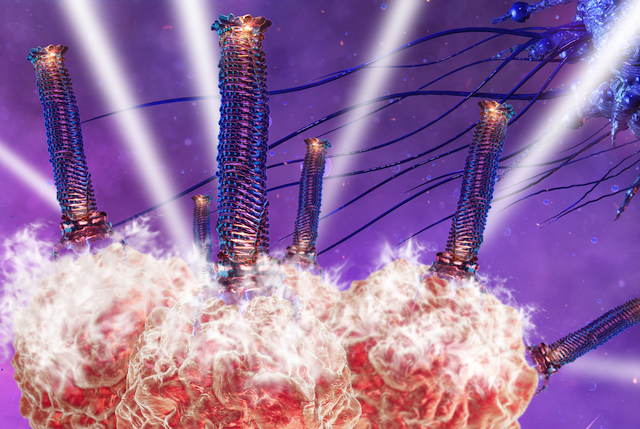Not all viruses are bad: a new photoactive viral vector for anti-cancer therapy has been developed

Even viruses can have a silver lining. A research team at the University of Bologna has developed a new targeted cancer therapy based on the action of a genetically modified phage, a virus that infects bacteria.
The study made the cover of the journal Nanoscale and was carried out as part of the NanoPhage project, supported by the AIRC (Italian Association for Cancer Research) Foundation. Results show that it is possible to engineer a particular type of virus, the M13 phage, to selectively eliminate only tumour cells. To this end, the virus has been modified in such a way that it can transport a drug that can be activated by light to the target tumour cells.
"Today, more than ever, we know that viruses can be dangerous enemies for humans. However, it is important to remember that some viruses can be valuable allies in the fight against diseases, including cancer" explains Matteo Calvaresi, professor at the University of Bologna's Department of Chemistry 'Giacomo Ciamician' and coordinator of the study.
Bacteriophages, or simply phages, are widespread viruses that affect bacteria, but are harmless to plants, animals, and humans. Because of this characteristic and their particular structure, they lend themselves to being genetically modified and thus transformed into vectors capable of transporting drugs within an organism in a targeted manner.
The researchers tested this opportunity with the M13 phage, a filamentous virus 1000 nanometres long but only 5 nanometres wide (one nanometre is one-billionth of a metre). Because of its characteristics, this virus can become an effective platform for hosting and transporting nanomaterials. More specifically, the aim of the study was to turn the virus into a tool for implementing an anti-cancer photodynamic therapy: a targeted, non-invasive treatment activated by light pulses.
"We have used this phage as a vehicle capable of directing several hundred molecules to the surface of cancer cells. These molecules then penetrate the cancer cells through a process, called endocytosis, mediated by receptors" says Luca Ulfo, a PhD student at the University of Bologna and co-first author of the study.
The researchers genetically modified the phage to selectively target a specific receptor called EGFR, which is over-expressed in several tumour types, including breast, lung, brain, and colon cancers. Thus, the virus only reaches the tumour cells. In addition, molecules that enable photodynamic therapy to be activated have been chemically attached to the protein envelope surrounding the virus genome.
"These molecules are compounds called photosensitisers, which can be activated by a light stimulus. Furthermore, they can transform the oxygen normally present in our bodies into a highly reactive chemical agent capable of killing cancer cells,” adds Andrea Cantelli, a researcher at the University of Bologna and co-first author of the study.
The modified virus can recognise tumour cells in a targeted manner. This makes it possible to precisely control the area in which the therapy is activated by irradiating it with light. These are features that could help to drastically reduce the side effects of cancer therapies. The obtained results are the first significant step towards a clinical trial of this viral vector, which could also find further medical applications.
"The uniqueness of this new tool lies in the great flexibility offered by the biology of the phage, which makes it possible to develop innovative approaches in the field of theranostics, biosensing, and precision medicine," explains Alberto Danielli, professor at the Department of Pharmacy and Biotechnology of the University of Bologna as well as one of the coordinators of the study. "In addition to our specific application, the virus could be modified in other ways to reach different types of cells, and even to fight pathogenic bacteria that have developed resistance to antibiotics."
The results were published in the journal Nanoscale in an article entitled 'Orthogonal nanoarchitectonics of M13 phage for receptor-targeted anticancer photodynamic therapy'. The study was carried out by a research team involving three departments of the University of Bologna: Luca Ulfo, Annapaola Petrosino, Paolo Emidio Costantini, Michela Nigro, Francesco Starinieri, Suleman Khan Zadran, Giampaolo Zuccheri e Alberto Danielli (Department of Pharmacy and Biotechnology); Andrea Cantelli, Roberto Saporetti, Matteo Di Giosia e Matteo Calvaresi (Department of Chemistry ‘Giacomo Ciamician’); Eleonora Turrini (Department of Quality of Life Sciences). The research was made possible thanks to the NanoPhage project, supported by the AIRC Foundation for Cancer Research, and active at the NanoBio Interface Lab.





